Ephraim Carmel, an artist, a scholar and
a friend, I'm happy to host his art in my site.
 Ephraim
Carmel born 1956 in Israel, he studied
philosophy and art history at
Ephraim
Carmel born 1956 in Israel, he studied
philosophy and art history at
Tufts University and at the school of the Museum of Fine Arts
in Boston and
graduated in 1982. Since 1984, he became a full time artist working
in
various materials, starting with paintings of 'Head of prophets'
on wood,
than 'jail doors', 'Olive oil steeped books', Alchemical glass
sculptures,
and the last few years the vast projects of 'Mystical Libraries'.
The Library
This project exposes hidden knowledge from
various Mystical Libraries that
are in existence today. By doing so, a new library emerges. This
library
already includes 50 such books from The Bibliotheca Hermetica
in Amsterdam
and from Warburg Institute in London.
Each placement of the books on the library
shelves and their freshly
revealed pages offer a detail from the Hermetical, Gnostic and
Cabalistic
magic philosophy and it's spiritual aim. This vast project of
bringing
together series after series of collected pieces of this special
knowledge
into context of contemporary thought.
Mystical
Library
Ephraim Carmel
This is a virtual, conceptual,
speculative presentation of what is or can be
a mystical library. The virtual aspect is the very existence of
knowledge
placed in the ** Metatron ** library of the seventh heaven.
Conceptually it is a work of secrets that the speculative power
rides on the
"light of the mind". The radical difference between
historiography is at the
core of some of the books, other explore the origin of things
and the
genealogy of existence.
1. ST. Adamman
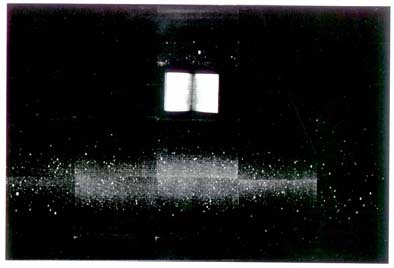
' Irish precursor of Dante
', by C.W.Boswell, 136cm x 212cm.
The Cabalistic ' Book of Enoch ' is
probably the most ancient non-pagan book
in existence. It relates in copious detail, how the seer was caught
up by
the vehement wind and upraised to heaven, where he was taken in
charge by
the archangel Michael, who revealed to him Hell and Paradise,
the mysteries
of nature and revelation, and life to come.
St. Adamman, the 8th Century Irish
precursor of Dante's vision of heaven and
hell, was deeply influenced by the ' Book of Enoch '. St. Adamman's
involvement with the Cabala served as the most elaborate contribution
to the
vision legend prior to Dante's ' Divine Commedia '. During the
period
between the 4th and the 8th Century, Ireland served as the only
repository
of knowledge in Europe, the only light in the darkness. This was
the time
when the Goths and the Visigoths destroyed the cultural backbone
of the
entire European Continent.
The 16th century philosopher Francis
Bacon, deplored the fact that barbarian
destruction by Atila and the Goths came to aid the Aristotelianism
to
complete the ruin of ancient wisdom: " After human science
suffered this
terrible wreck ", he said. " the plank of Aristotelian
philosophy surfaced
and was thus saved as something lighter and less substantial ".
But, the
ancient tradition was not totally obliterated as Francis Bacon
believed. It
was preserved in Ireland. Concentrated in the oldest center of
learning in
Europe as the monasteries of Clonmmacmoise on the river Shannon.
This was a
time when Ireland was called " The land of saints and scholars
". It might
not be too bold to suggest that if this knowledge was not kept
in Ireland at
that crucial period, the ' Divine Commedia ', let alone the entire
Italian
Renaissance would not have been possible.
This book by St. Adamman links Cabala
with Dante's Commedia at a time when
human wisdom itself was a hidden tradition.
2. Milton

'Milton & The Conjectura
Cabbalistica' by R.J. Zvi Werblowsky, 136 cm x 212cm.
One of the most daring of Cabalistic
concepts found it's way into Milton's '
Paridise Lost ': "...I uncircumscribed myself retire, and
put not forth my
goodness, which is free to act or not ". The doctrine of
'Tsimtsum' is a
highly mystical one, though it's initial starting point is a gross
and naive
naturalism. With God's infirmity being all and feeling all, there
was no
space for creation. God therefore withdrew " Himself from
Himself ", not
concentrating at a point but retreating away from His center to
His
circumference as it were. He now no longer fills all, but leaves,
in the
middle of Himself, a vacuum in which creation can take place.
It should be
noted that God does not construct or concentrate, but rather retires
sideways to the periphery. This retraction of 'Tsimtsum' is a
dynamic act,
the first step in the dynamic of creation. When Milton in his
'Paradise
Lost' discusses the place of individual being he had a problem.
From the
absolute, nothing can proceed. As Milton says, he was neither
reason nor
power to change into a less perfect state. How is it possible
then to derive
from the absolute, the only necessary cause of all that is, the
existence of
limited individual being? This is the most important problem for
all
philosophies of the absolute, for they recognise that here exists
an un
explainable, an irritational abyss, between God and his creatures,
between
the absolute and nature.
At the foundation of the world there
comes into play an illogical power,
which has no common measure with reason. Milton saw the problem.
He found no
solution that could be drawn from the scripture of theology. So
he boldly
took this concept from Lurianic Cabala and made it the very center
of his
methaphisics. According to his plan, God withdraws his will from
certain
parts of himself, and delivers them up, so to speak, to obscure
latent
impulsions that remain in them. Through this "retraction",
matter is
created; through this reaction, individual beings are created.
The parts of
God thus freed from his will become people.
3. Theatre

'Theatre & Alchemy'
by Bettina L. Knapp, 152cm x 240cm.
Alchemy is a science, psychology and
metaphysics. It is also theatre.
Antonin Artaud wrote: " There is mysterious identity of essence
between the
principle of theatre and that of alchemy. When alchemy, through
it's
symbols, is the spiritual double of an operation which functions
only on the
level of real matter, the theatre must also be considered as a
double, not
of this direct, everyday reality of which it is gradually being
reduced to a
mere inert replica...but of another archetypal and dangerous reality,
a
reality of which the principals, like dolphins, once they have
shown their
heads, hurry to dive back into obscurity of the deep." Alchemists
believe in
their ability to change impure leaden metal to a higher and more
perfect
golden essence. A parallel exists between their scientific activities
and
their methaphisical beliefs; as metals could be purified, so mankind
could
be elevated from dross to it's spiritualized essence. The stages
to
incorruptibility were described by the alchemist in terms of color.
Three
different psychological stages in the development of human personality
correspond, Jung wrote to the three part alchemical process. 'Nigredo',
the
blackening process is man's inner turmoil. 'Albedo', the whitening
stage, is
the birth of duality and with it a deepening self knowledge. 'Rubedo',
a
reddening phase, is where incorruptibility rises to it's most
powerful
intensity. The 'Escurial' belong to the first stage, 'Nigredo'.
Claudel's
'Break of Noon', Yeats's 'The Only Jealousy of Elmer' and Witkiewiz's
'Water
Hen' belong to the second stage, 'Albedo'. 'The Dybbuk', by Shalom
Ansky
belong to the third stage, 'Rubedo'. 'The Dybbuk' dramatizes a
love which
cannot be broken, even in death. 'The Dybbuk' is also a mystical
document.
The cabalistic "White Fire on Black Fire" leads to the
'mysterium
coniunctionis' at the plays finale. The union opposites occurs,
an
integration of antagonistic forces. Once opposing polarities were
welded
together, everything within the cosmos formed a cohesive whole,
enabling a
renewal to take place.
4. Mathematics
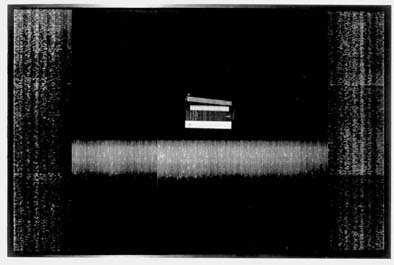
'John Dee-Natural Philosophy'
by Clulee
'Philo Judeans-Jewish Alexandrian
Philosophy' by Drummond
'Plotinus Philosophy'
'Alexandria' by Temenos
Society
126cm x 191cm.
Numbers contain certain keys for solving
the mysteries of nature. Numbers
influence the character of things that are ordered by them. Thus
the number
becomes a mediator between the Divine and the create world. It
follows that
if one performs operations with numbers, these operations also
work upon the
things connected with numbers used.
The special metaphysical meaning of
numbers is the subject of this shelf.
Plotinus, whose neoplatonic system deeply influenced the mystical
trend in
the three Abrahamic religions, remarked: "Numbers exist before
the objects
described by them. The variety of sense objects merely recalls
to the soul
the notion of number". Continuing this line of thought, Philo
of Alexandria
combined ideas from the Old Testament and the Pythagorean tradition
and thus
created the basis for the Biblical exegesis of the Middle Ages,
which is
heavily determined by number mysticism. The most important development
of
the Pythagorean tradition in the medieval world is the Jewish
Cabala which
is based upon a highly complicated number mysticism, where by
the
promercifal one divides itself into ten Sephirot. Since the Hebrew
letters
also serves as numbers, the figure of the Sephirot and it's derivates
lead
to fascinating relations between the different parts of the world.
The vast
field of the Cabalistic hermeneutics is permeated by number mysticism.
John
Dee, the Elizabetean mathematician, sought the spiritual side
of numbers in
his investigating of "Measured verse" in the French
academies and later in
his more personal Cabalistic angeology.
The Cabalistic technique, 'gematria',
the use of numerical equivalent of
letters to reveal hidden meanings, was used extensively by Dee.
Numbers
associated with individual letters not only had mystical significance,
but
if the sum of the numerical values of the letters of two words
was the same,
the two words could be considered identical in meaning. In Dee's
'Monas
Hyroglyfica', he showed how 'Gematria', 'Notaricon' and 'Tsiruf'
were Hebrew
exegetical techniques which were used extensively in Cabala to
derive
hidden, mystical and at times magical significance from the Old
Testament.
John Dee wrote in the Monas: "Mathematics is thus next to
Theology in
dignity and an indispensable aid in attainment of 'Heavenly Wisdom'".
Following Plato in 'The Republic', Dee urges that "the study
of mathematics
leads to mind the abandon sense objects and prepares it to conceive
intellectual and spiritual things".
5. Alexandria
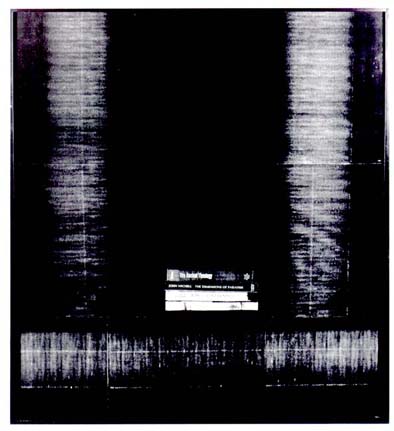
'The Vanished Library' by
Luciano Canfora.
'Lost Gospels' by Stephen
A. Hoeller.
'The Dimensions of Paradise'
by John Michell.
'Ancient Theology' by Walker.
117cm x 104cm.
The Alexandrian Library was the birthplace
of Gnosticism where Syncretism
was employed in a most daring attempt to integrate the entire
knowledge of
the ancient world for the purpose of creating a universal science.
The work
is one in a series about important libraries in the history of
human
thought.
6. Eckhart
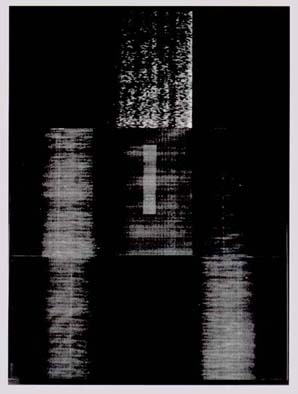
'Treaties of Detachment'
by Meister Eckhart.
127cm x 95cm.
Meister Eckhart, the fourteen century
German Mystic and theologian, is one
of the most enigmatic and controversial figures in the history
of the
church. A Christian mystic and a Buddhist sage Eckhart has been
seen as a
heretic that played a radical and fertile role in the cultural
imagination.
The work is one in the series of mystical personalities.
7. Zohar
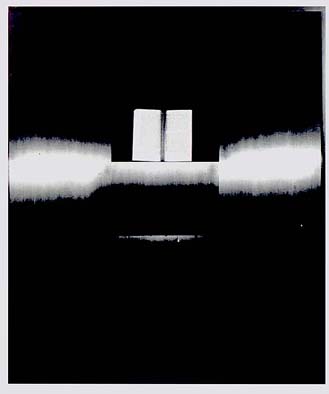
'The Wisdom of Zohar' by
Isaia Tishby, 130cm x 147cm.
'The Zohar', or otherwise called 'The
Book of Splendour', is one of the
richest item in the Treasury of Jewish mystical thought. It has
served many
generations as a guide throughout life's complexities, and as
a source of
inspiration for visionaries and initiates, who immersed themselves
in it's
mysteries. The central idea around which the Zohar's treatment
of conjugal
life revolves is that the relation between man and woman reflect
those of
The Holy One, and the 'Shekina'. Although the author of the Zohar
designates
the imperfection of bachelorhood as "half the body",
he really means "half
the soul", because he believed that all the souls before
they descended into
the physical world were bisesexual, a combination of male and
female. Most
passages that deal with this topic assume that souls are bisexual
from the
moment of their formation with the 'shekina', and that before
they enter
their respective bodies they are split up by the angel in charge
of
conception. However, a passage concerning the halls in the upper
world says
that the souls are all created male and females separately, and
they descend
individually to the first hall, where they become souls comprising
male and
female together, and they fly from this hall and are seperatedamong
mankind.
The reunification of half-souls in the physical world is accompanied
by many
difficulties. Only the person whose way of life is praiseworthy
can be
reunited without trouble with it's original counterpart. Those
women or man
who cannot be married to their original partners because of the
latter's
evil deed are taken by partners who have entered the world by
means
transmigration of soul and who have not been designated partners
from the
upper world. There are occasions when a female partner comes into
the world
before the male, and she is given marriage to someone else until
her real
partner has grown old enough to mary her.
The concept of human male/female relationships
as a miror of the system of
divine forces gives a definite sacral character to married life,
and
particularly the sexual act itself, which reflects and embodies
in this
world divine intercourse in the world above. Indeed, it helps
to bring it
about and attracts a flow of blessing from it down to the physical
world.
During intercourse the partners should try to combine the attribute
of day
with night and the attribute of night with day.
8. Death
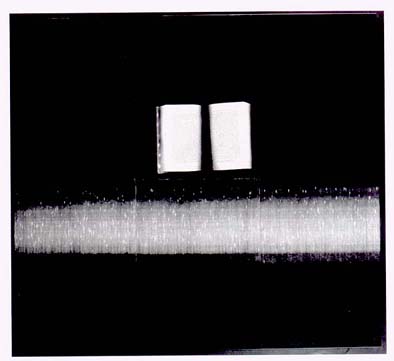
'The Grail Legend' by Emma
Jung & Maria Louise von Frans, 131cm x 122cm.
To be dead and buried - an incomprehensible
stae of existence - is looked
upon as a primary condition and as a starting point for the alchemical
'opus', in contrast to the general view that a burial comes at
the close of
life. The recovery of the hidden treasure though that process
brings forth
Heraclitus mystical dictum: "We live the death of the immortals
and they
live ours".
9. God
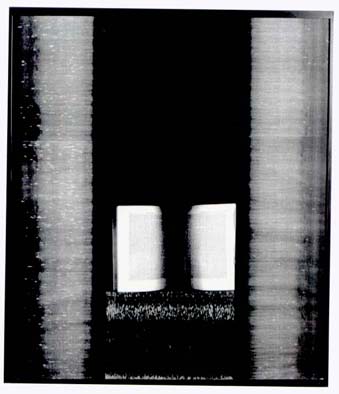
'Encyclopedia of Religion'
by Myrcea Eliade.
124cm x 107cm.
This work is one of a series of thirteen
definitions of God according to:
Iranian, Jewish, Muslim, Buddhist, Greek, Arabian, Chinese, Primitive
and
Savage, Teutonic, Biblical and Christian traditions.
10. Maimonides
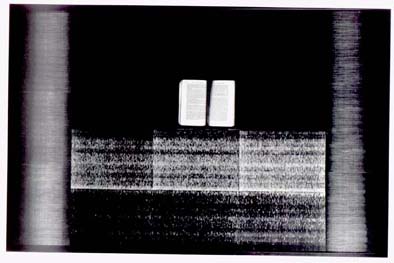
'The Guide to the Perplexed'
by Maimonides.
121cm x 188cm.
When Maimonides embarked upon the
explanation of the secrets of the Torah,
he was confronted with the apparently overwhelming difficulty
created by the
"legal prohibition" against explaining those secrets.
The very same law, the
secrets of which Maimonides attempted to explain, forbids their
explanation.
According to the ordinance of the Talmudic sages, the chariot
visions of
Ezkiel (Ma'aseh Merkabah) ought not to be taught even to a man,
except if he
be wise and able to understand by himself, and even to such a
one only the
chapter headings may be transmitted. "You will not demand
from me here (in
the 'Guide to the Perplexed') anything except chapter headings,
and even
those headings are, in the treatise, not arranged according to
their
intrinsic order or according any sequence whatsoever, but they
are scattered
and intermingled with other subjects, the explanation of which
is intended".
It is true Maimonides makes this statement with regard to the
explanation of
'Ma'aseh Merkaba' only. But can be no doubt that he followed the
same method
in his explanation of creation (Ma'aseh Bereshit) and indeed,
all the
secrets of the Torah. The guide is devoted to the explanation
of an esoteric
doctrine.But his explanation is itself of an esoteric character.
The mystic part of Ezekiel's book
begins with the statement that "God opened
to Ezekiel seven divisions of the lower world and as Ezekiel was
looking at
them, he saw everything that was in heaven". The divisions
mentioned here by
their names are subterrestrial "earths", that is, layers
of seven earths
which correspond to the seven heavens. In fact, the vision of
Ezekiel
incorporates elements of cosmological speculation, the nature
and
significance of which are beyond common mystical interest, here
the basic
structure of the universe is referred to, though, as might be
expected, only
the celestial world receives extensive attention. As a matter
of mystical
technique, Ezekiel is described as looking downward and seeing
what is
above.
Using water as the mirror to the heavens,
Ezekiel reveals a "mystical
collection" of the most detailed descriptions of the Deity
and his retinue
to be found in the Bible. the text obscurities could easily have
seemed as
veils thinly cloaking a divine mystery, which could be penetrated
if only
the prophet's language could be understood. The question naturally
arises as
to how Maimonides came into the possession of this understanding?
We can
assume that he owed his entire knowledge of the secrets to an
uninterrupted
oral tradition going back to the time of the second temple and
beyond. We
could then be forced to admit that Maimonides was a Cabalist,
since the
content of the guide would be nothing but a secret teaching based
on oral
tradition. Indeed, as it seems that there had existed no Cabala,
strictly
speaking, before the completion of the guide, one might suggest
that
Maimonides was one of the earliest Cabalists.
11. Camillo
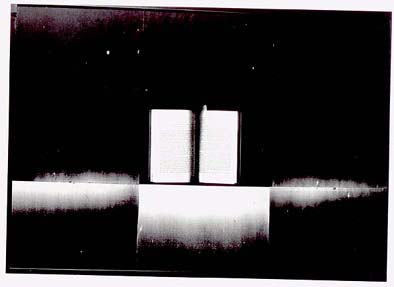
'The Art of Memory' by Francis
A. Yates.
86cm x 99cm.
This work exposes the remarkable Hermetic-Cabalist
memory theatre of Julio
Camillo, one of the most famous men of the sixteen century. For
Camillo, it
is the correspondence of the seven planetary measures of the celestial
world
with the upper-celestial Jewish Sephirot, which gives the theatre
it's
prolongation into the Abyss of the divine wisdom and the mysteries
of the
temple of Solomon. As well as the adoption of the Jewish Sephirot
and angels
and their connections with the planetary spheres, there are numerous
other
Cabalistic influences in the theatre, the most noteworthy of which
is the
quotation from the Zohar on a man having three souls; 'Neshama'
the highest
soul; the middle soul, 'Ruach', and the lower soul, 'Nefesh'.
This
Cabalistic concept he invests with the image of the three Gorgon
sisters,
with one eye between them, as the leading image on the grade of
the theatre
dealing with the 'interior man'. After mentioning 'Neshama', 'Ruach'
and
'Nefesh' as the three souls, of which one nearest to God is called
by
Mercurius Tresmagistus and Plato 'Mens', by Moses the spirit of
life, by
St.Augustine the higher part, by David-light, when he says 'in
thy light
shall we see light', and Pitagoras agrees with David in that celebrated
precept, 'no man may speak of God without light'. That light called
by
Aristotle the 'Intellectus Agens', and it is that one eye by which
all the
three Gorgons sisters see, according to the symbolic theologians.
Mercurius
says that if we join ourselves to this 'Mens' "We may understand,
though the
way of God which is in it, all things, past, present and future,
all things
I say which are in heaven and earth".
12. Alchemy
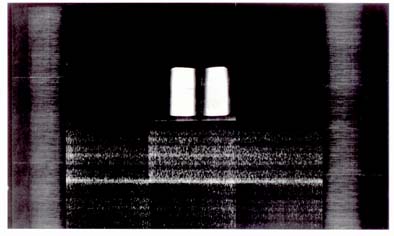
'Alchemical Studies' by
C. G. Jung.
130cm x 184cm.
Alchemy can be interpreted in many
ways: as the art of gold making, as a
symbolical representation of mystical doctrines, or as in writings
of
C.G.Jung, as a projection of the unconscience mind, concerned
with the
integration of the personality. In the alchemical studies he refers
to the
philosophical tree through the words of 'Goethe's Faust: "all
theory my
friend is Gray, but green is life's golden tree". An image
which frequently
appears among the archetypal configurations of the unconscious
is that of
the tree or the wonder working plant. That wonder working plant
is viewed in
Jung's psychology as a tree that symbolizes the self depicted
as a process
of growth. Like the vision of Zaratustra, the dream of Nebuchadnezzar,
and
the report of Bardesanes on the God of the Indians, the old Rabbinic
and
Cabalistic idea that the tree of Paradise was a man exemplifies
man's
relationship to the Philosophical tree. According to the ancient
tradition
man came from trees or plants. The tree is as it were an intermediate
form
of man, since on the one hand it springs from the primordial man
and on the
other it grows into a man. The philosophical tree can be compared
with
Cabalistic Sepheriodic Tree, which is actually a mystical world
tree that
signifies man. That man is an inverted man or an inverted tree.
he is
implanted in Paradise by the roots of his hair, as the reference
in the
'Song of Songs': "Thy head is like Carmel, and the hairs
of the head as the
purple of the King bound in the channels". The channels are
tubes of glass
that brought light down to the lower world. Because it stood in
the middle
of the Garden of Eden it was called the 'linea media' (middle
line). Through
this middle line, which as it were the trunk of the Sephirot system,
it
brought life down to earth. One can bring the concept of the inverted
man
between Faust and Plato, where the latter professes in an orphic
fragment.
"But the soul in man is rooted in the ether".
13. Psychic
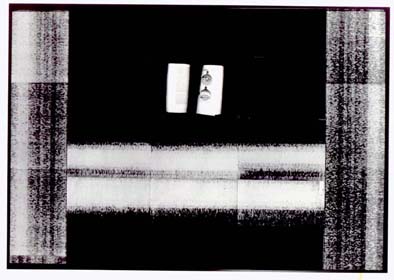
'Psychology and Alchemy'
by C.G.Jung.
130cm x 184cm.
Alchemical work according to Jung
has a psychic nature. The projection of
psychic content is never made; it happens, it is simply there.
"In the
darkness of anything external", Jung wrote, "I find
without recognizing it
as such, as interior or psychic life that is my own". The
psychic
projections of the individual played a major part in alchemical
works. While
working on his chemical experiments the alchemist had certain
psychic
experiences which appeared to him as the particular behavior of
the chemical
process. Since it was a question of projection, he was unaware
of the fact
the experiment had nothing to do with matter itself. He experienced
his
projection as a property of matter, but what he was in reality
experiencing
was his own unconscious. In this way he recapitulated the whole
history of
man's knowledge of nature. As we all know, science began with
the stars, and
mankind discovered in them the dominants of the unconscious, the
"gods", as
well as the curious psychological qualities of the zodiac: a complete
projection theory of human character. Astrology is a primordial
experience
similar to alchemy, Such projections repeat themselves whenever
man tries to
explore an empty darkness and involuntarily fills it with living
form.
In the "Tractatus Aristolehs"
Jung illuminated a passage that is noteworthy
from the point of view of the alchemist psychology. "The
Serpent is more
cunning then all the beasts on earth; under the beauty of her
skin she shows
a harmless face, and she forms herself in the manner of a 'materia
hypostatica', though illusion, when immersed in water. There she
gathers
together the virtues from the earth, which is her body. Because
she is very
thirsty she drinks immoderately and becomes drunken, and she causes
the
nature wherewith she is united to vanish".
The serpent is Mercurius, who as a
fundamental substance forms himself in
the water and swallows the nature to which he is joined. The Mercurial
serpent devouring itself in water and fire is actually the Gnostic
serpent
who eats it's own tail. This symbolizes the regeneration of nature's
place
in human character and can only be achieved when the former self
vanishes
beneath the arrival of the new self.
The catalogue
by Montpelier Sandelson Gallery, London, United Kingdom
All the pictures
are fo sale - for viewing, prices and further information please
contact:
Efi Carmel
36 Colville Terr. #Flat
4
London W. 11 2.B.U
United Kingdom
Tel: 44 -171- 727- 47- 42
 EMAIL US
EMAIL US  Guest
book
Guest
book 
 Ephraim
Carmel born 1956 in Israel, he studied
philosophy and art history at
Ephraim
Carmel born 1956 in Israel, he studied
philosophy and art history at











